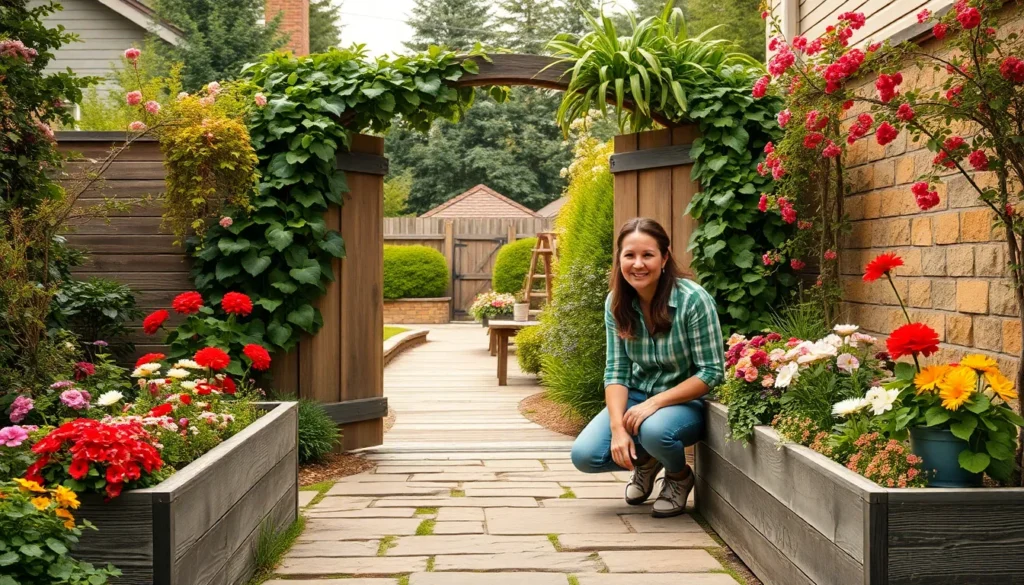Walking into a garden should feel like stepping through a portal into your own personal paradise. The entrance sets the tone for everything that follows—it’s the first impression that determines whether guests feel enchanted or simply notice another yard. We’ve discovered that the right garden entrance transforms an ordinary outdoor space into something truly magical.
Whether you’re working with a grand front yard or a cozy side garden, your entrance deserves thoughtful design. From rustic wooden gates that whisper of countryside charm to sleek modern archways that make bold statements, the possibilities are endless. We’ve seen how small changes like strategic lighting or climbing vines can completely revolutionize a space.
The best part? Creating an stunning garden entrance doesn’t require a massive budget or professional landscaping skills. We’ll show you practical ideas that work for every style and space, helping you create an entrance that welcomes visitors and makes you smile every time you come home.
Create a Grand Entrance With Arbors and Pergolas
Arbors and pergolas transform ordinary garden entrances into stunning architectural focal points that welcome visitors with style and elegance. These vertical structures create dramatic height and visual interest while providing the perfect framework for climbing plants and decorative elements.
Choose the Right Material for Your Climate
Cedar and redwood offer exceptional durability in wet climates thanks to their natural resistance to rot and insects. We recommend these premium woods for Pacific Northwest gardens where moisture levels remain consistently high throughout the year.
Aluminum and steel structures withstand extreme weather conditions without warping or deteriorating over time. These metal options work exceptionally well in areas with harsh winters, intense sun exposure, or frequent temperature fluctuations.
Pressure treated pine provides an affordable solution for moderate climates where budget considerations take priority over longevity. This material typically lasts 10-15 years with proper maintenance and regular staining or sealing.
Vinyl and composite materials require minimal maintenance while offering consistent appearance year after year. We find these synthetic options particularly valuable for busy homeowners who want beautiful garden entrances without ongoing upkeep responsibilities.
Add Climbing Plants for Natural Beauty
Clematis vines produce spectacular blooms in purple, pink, white, and blue colors that create stunning seasonal displays across pergola tops and arbor sides. These flowering climbers thrive in full sun to partial shade conditions.
Climbing roses establish romantic garden entrances with their fragrant blooms and classic appeal that never goes out of style. We suggest varieties like Eden, New Dawn, or Climbing Iceberg for reliable performance and disease resistance.
Grape vines offer dual purpose functionality by providing both attractive foliage and edible fruit harvests each fall season. These vigorous growers quickly cover structures while creating natural shade and privacy screens.
Wisteria creates dramatic cascading flowers in spring that transform simple wooden or metal frameworks into breathtaking garden features. But, we recommend regular pruning to prevent these aggressive vines from overwhelming smaller structures.
Incorporate Built-in Seating Options
Bench seating along pergola sides creates intimate gathering spaces where family members and guests can pause to enjoy garden views and natural surroundings. We recommend 18-inch seat heights with 15-inch depths for optimal comfort.
Corner seating arrangements maximize small entrance areas by utilizing space efficiently while providing multiple seating positions for conversation and relaxation. These L-shaped configurations work particularly well under square or rectangular pergolas.
Storage benches combine functionality with comfort by offering hidden compartments for garden tools, cushions, or outdoor accessories beneath hinged seat tops. This dual purpose design keeps entrance areas organized and clutter free.
Curved bench designs soften angular pergola structures while creating flowing lines that complement natural garden elements like curved pathways or rounded planting beds. We find these organic shapes particularly appealing in cottage style and informal garden settings.
Design a Welcoming Pathway Leading to Your Garden
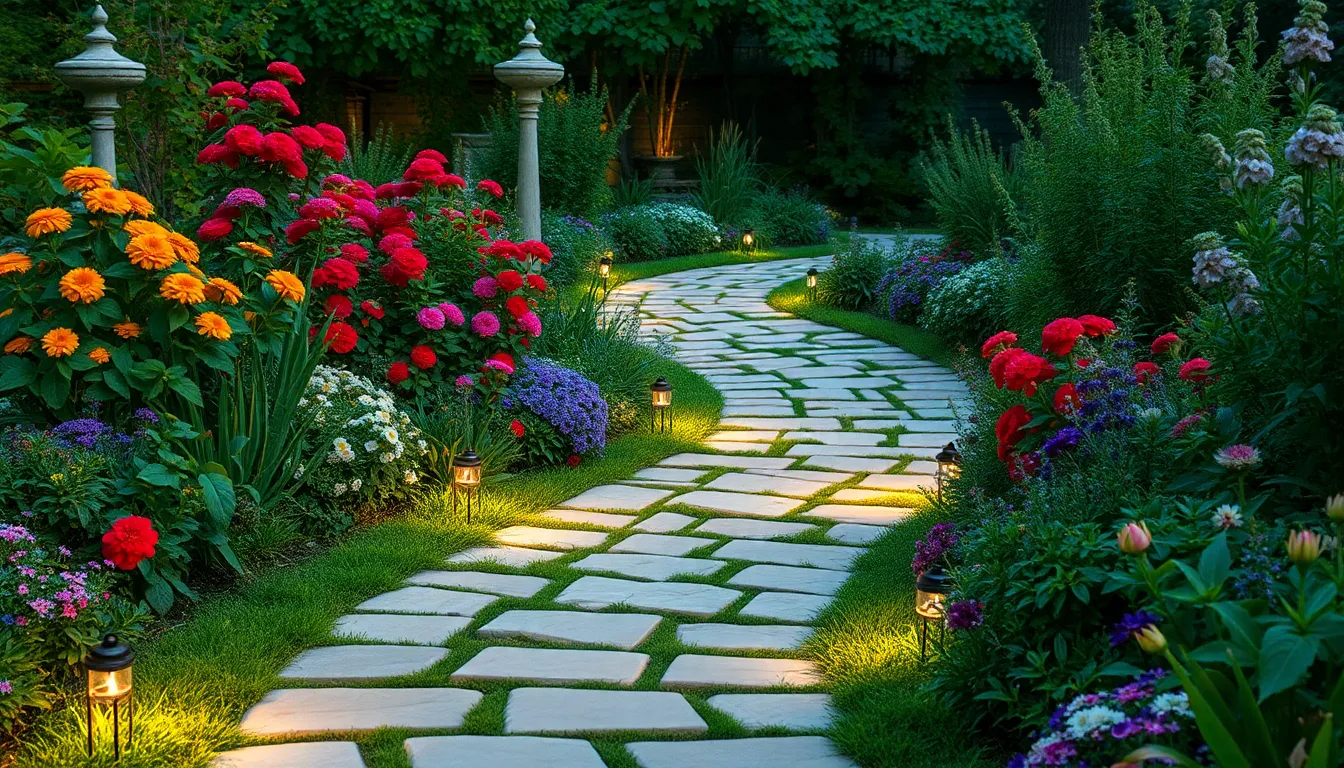
The pathway to your garden serves as the crucial bridge between your entrance features and the natural beauty beyond. Creating this connection thoughtfully ensures visitors experience a seamless transition from arrival to exploration.
Use Natural Stone for Timeless Appeal
Natural stone creates pathways that blend effortlessly with various garden styles while providing exceptional durability. Flagstone, limestone, and slate offer classic options that weather beautifully over time, developing character that enhances your garden’s overall aesthetic.
Selecting the right stone depends on your climate and design preferences. Sandstone works well in dry climates, while granite handles freeze-thaw cycles effectively in colder regions. These materials require minimal maintenance compared to other paving options.
Installation techniques vary based on stone type and desired formality. Irregularly shaped flagstones create rustic charm when set with wide joints filled with moss or ground cover plants. Cut stone pieces arranged in geometric patterns deliver more formal appearances suitable for contemporary garden designs.
Create Curved Walkways for Visual Interest
Curved pathways generate ever-changing visual movement that draws visitors naturally toward your garden entrance. These flowing lines work particularly well when connecting driveways to front doors or leading guests into backyard spaces, creating anticipation for what lies ahead.
Planning your curve requires considering natural sight lines and existing industry features. Gentle S-curves feel most organic, while sharp turns can create dramatic reveals of garden focal points. The pathway width should accommodate comfortable walking while maintaining proportional relationships with surrounding plantings.
Materials for curved walkways include flexible options like brick, small pavers, or decomposed granite that adapt easily to flowing lines. Edging becomes crucial for maintaining clean curves, with steel, aluminum, or flexible plastic strips providing the necessary structure to hold materials in place.
Install Proper Lighting for Evening Access
Strategic lighting transforms garden pathways into inviting evening destinations while ensuring safe navigation after dark. Path lights, bollard fixtures, and recessed step lighting work together to illuminate walking surfaces without creating harsh glare.
Low voltage LED systems offer energy efficiency and easy installation for most residential applications. Solar powered options eliminate wiring requirements while providing adequate illumination for moderate traffic areas. Timer controls and photocell sensors automate operation for convenience.
Placement considerations include spacing fixtures every 6 to 8 feet along pathway edges to avoid dark spots between lights. Highlighting architectural features like arbors or plantings adds visual interest while maintaining functional illumination. Warm color temperatures between 2700K and 3000K create welcoming ambiance that complements natural garden settings.
Install Eye-Catching Garden Gates
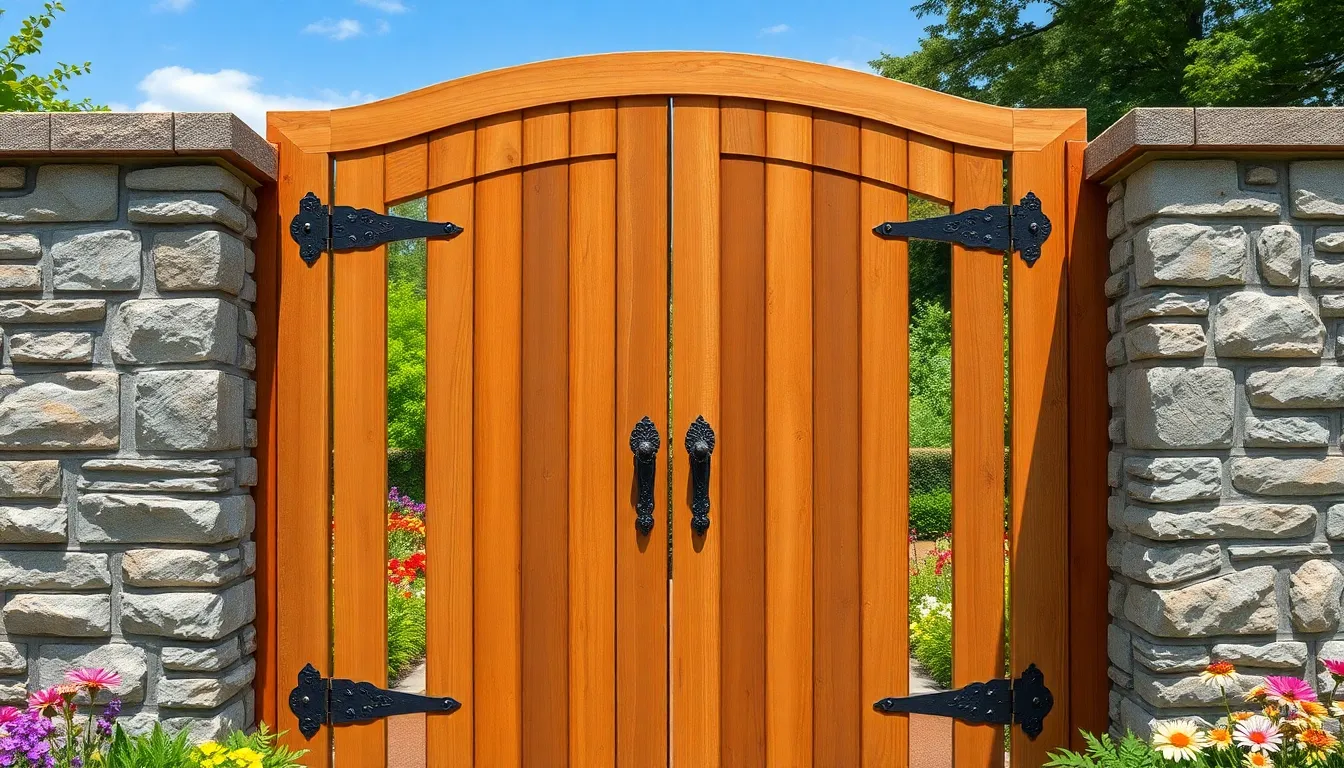
Creating a stunning focal point for your garden entrance starts with selecting the perfect gate that complements your outdoor space. We’ll explore the key elements that transform an ordinary entrance into an extraordinary welcome statement.
Select Materials That Match Your Home’s Style
Wood gates offer timeless appeal and natural warmth that pairs beautifully with traditional and rustic home designs. Cedar and redwood provide excellent weather resistance while developing an attractive patina over time. Pine options deliver budget-friendly answers when treated properly for outdoor use.
Metal gates bring durability and sophisticated elegance to contemporary and modern architectural styles. Wrought iron creates ornate patterns perfect for Victorian or Mediterranean homes. Aluminum provides lightweight strength with minimal maintenance requirements for busy homeowners.
Vinyl gates deliver low maintenance convenience without sacrificing visual appeal. These materials resist fading, cracking, and warping in extreme weather conditions. Composite options combine wood aesthetics with synthetic durability for the best of both worlds.
Stone pillars enhance any gate material by creating substantial anchor points that command attention. Natural stone like limestone or fieldstone blends seamlessly with industry elements. Brick columns offer classic charm that complements colonial and craftsman style homes.
Add Decorative Hardware and Handles
Ornate hinges serve as jewelry for your garden gate while ensuring smooth operation for years. Cast iron hinges with decorative scrollwork add vintage character to wooden gates. Stainless steel options provide clean lines perfect for modern designs.
Custom handles create memorable touchpoints that reflect your personal style preferences. Antique brass lever handles evoke old industry charm on traditional gates. Contemporary stainless steel pulls offer sleek functionality for minimalist designs.
Decorative latches combine security with visual interest through thoughtful design choices. Thumb latches provide easy one handed operation while maintaining period appropriate aesthetics. Magnetic latches offer invisible convenience for ultra modern installations.
Specialty hardware includes decorative elements like gate stops, cane bolts, and drop rods that enhance both form and function. Weather resistant finishes ensure long lasting beauty even though outdoor exposure. Powder coated options resist rust and corrosion better than traditional paint.
Consider Automated Options for Convenience
Electric gate openers transform daily garden access into effortless convenience with remote control operation. Swing gate motors handle gates up to 16 feet wide and 800 pounds. Sliding gate systems work well for wider openings with limited clearance space.
Solar powered systems eliminate electrical wiring requirements while providing environmentally friendly operation. Battery backup ensures reliable function during cloudy weather periods. Smart controllers allow smartphone operation from anywhere in the industry.
Safety features include obstacle detection, automatic closing timers, and emergency manual override capabilities. Photoelectric sensors prevent gate closure when people or pets are present. Flashing warning lights alert visitors to gate movement for enhanced safety.
Access control options range from simple keypads to sophisticated biometric systems for ultimate security. Intercom systems allow communication with visitors before granting entry. Smartphone apps provide visitor logs and remote monitoring capabilities for peace of mind.
Build Raised Planter Boxes as Entry Features
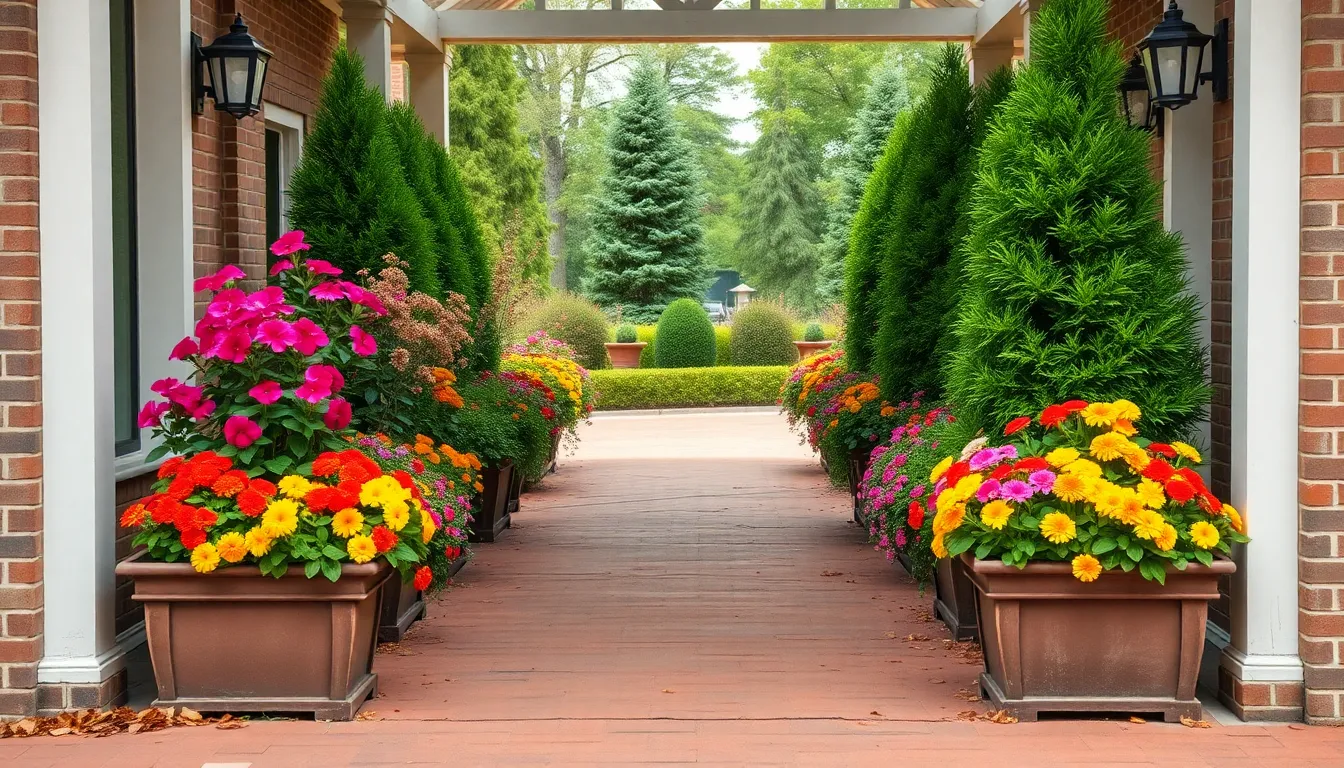
Raised planter boxes create structure and visual definition that transforms any garden entrance into an organized, welcoming space. We recommend constructing these features from durable materials like wood, stone, or composite lumber to ensure longevity while providing easier maintenance through reduced back strain and simplified weed control.
Frame Your Entrance With Seasonal Flowers
Seasonal flower displays along your entryway path create ever-changing color changes that keep your entrance fresh throughout the year. We suggest planting vibrant annuals like petunias, marigolds, and impatiens for spring and summer impact, while incorporating evergreen shrubs such as boxwood or holly for consistent winter structure. Dual border plantings on both sides of your walkway guide visitors naturally toward your entrance while offering visual variety that changes with each season.
Succession planting ensures continuous blooms by staggering flower varieties that peak at different times. We’ve found that combining early spring bulbs like crocuses and daffodils with mid summer perennials creates seamless seasonal transitions. Fall additions such as chrysanthemums and ornamental kale extend your display well into autumn months.
Choose Plants That Thrive in Your Zone
Climate appropriate plant selection maximizes growth success while minimizing maintenance requirements for your entrance garden. We recommend researching your USDA hardiness zone to identify native species and drought resistant varieties that naturally flourish in your local conditions. Native plants like purple coneflowers, black eyed Susans, and regional ornamental grasses require less water and fertilizer while supporting local wildlife.
Zone exact choices also reduce replacement costs since properly matched plants survive harsh weather conditions better than exotic varieties. We suggest consulting your local extension office for recommended species lists that include bloom times, mature sizes, and care requirements. Drought tolerant options such as lavender, sedum, and ornamental sage work particularly well in raised planters where drainage is excellent.
Add Integrated Irrigation Systems
Integrated irrigation delivers water efficiently to plant roots while conserving resources through reduced evaporation and targeted application. We recommend installing drip lines or soaker hoses in your raised planter boxes to provide consistent moisture without water waste. These systems work especially well in elevated plantings where manual watering can be challenging to maintain consistently.
Automated timers transform your irrigation system into a hands off solution that waters plants during optimal early morning hours. We’ve observed that programmable controllers allow you to adjust watering schedules seasonally, delivering more water during hot summer months and reducing frequency during cooler periods. Smart irrigation systems with soil moisture sensors prevent overwatering by monitoring actual plant needs rather than following rigid schedules.
| Irrigation System Type | Water Efficiency | Installation Cost | Maintenance Level |
|---|---|---|---|
| Drip Lines | 90-95% efficient | $50-150 | Low |
| Soaker Hoses | 80-90% efficient | $25-75 | Very Low |
| Smart Controllers | 85-92% efficient | $100-300 | Medium |
| Basic Timers | 75-85% efficient | $20-60 | Low |
Incorporate Water Features for Tranquil Ambiance
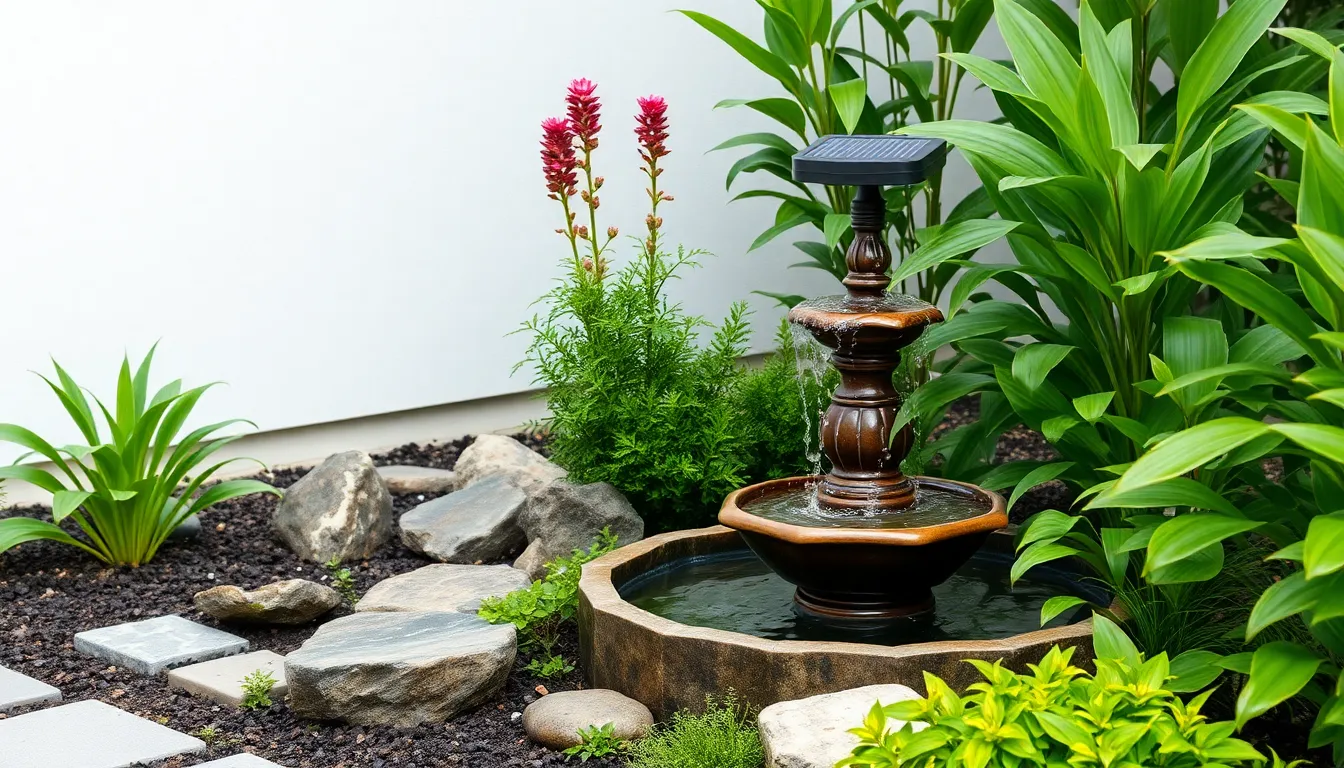
Water features transform an ordinary entrance into a serene gateway that soothes visitors before they even step foot in your garden. These elements create natural focal points while adding the therapeutic sounds of flowing water to enhance your entrance design.
Install Small Fountains or Bubblers
Small fountains serve as perfect entrance companions by generating gentle, welcoming sounds that draw visitors toward your garden space. Position these compact water features near your main entrance where guests can immediately hear and appreciate the calming effects. Bubbler systems create subtle water movement through submerged fountains that produce delicate bubbling effects on the surface without overwhelming the space.
Installation requires minimal ground preparation since most small fountains operate as self contained units with built in water reservoirs. Choose fountains that complement your existing entrance materials, whether you’ve selected natural stone pathways or modern architectural elements. Maintenance stays manageable with regular water level checks and seasonal cleaning to prevent algae buildup.
Create Reflecting Pools With Surrounding Plants
Reflecting pools add depth and symmetry to entrance designs by capturing mirror images of surrounding architecture and plantings. These shallow water features work exceptionally well when positioned to reflect your entrance arbor, pergola, or decorative gate elements. Strategic placement near your pathway creates visual interest while maintaining the serene atmosphere you’ve established.
Plant selection becomes crucial for maximizing the reflective qualities of your pool design. Water lilies provide floating elegance while their broad leaves create natural contrast against the water’s surface. Ornamental grasses planted around the pool perimeter add vertical elements that enhance reflections during different seasons.
Depth considerations keep maintenance simple while achieving maximum visual impact. Most reflecting pools function effectively at 12 to 18 inches deep, providing adequate space for aquatic plants while preventing stagnation issues.
Add Solar-Powered Options for Eco-Friendly Appeal
Solar powered pumps eliminate electrical installation costs while reducing ongoing energy consumption for your water feature operations. These systems harness sunlight through small photovoltaic panels that power fountain pumps during daylight hours. Battery backup options extend operation into evening hours when you’ve incorporated pathway lighting systems.
Eco friendly materials complement solar technology by using natural stone, recycled concrete, or sustainably sourced wood for water feature construction. Combined with native plant selections around your reflecting pools, these choices create environmentally conscious entrance designs that require minimal resource inputs.
Energy efficiency improves significantly with solar options since traditional electric pumps consume continuous power throughout operating periods. Most solar fountain systems include adjustable flow controls that optimize water movement based on available sunlight, ensuring consistent performance regardless of weather conditions.
Use Creative Signage and Garden Art

Adding personal touches through signage and artistic elements transforms your garden entrance from ordinary to extraordinary.
Design Custom Welcome Signs
Custom welcome signs let us reflect our home’s unique style and personality right at the entrance. We can create these personalized pieces from various materials including wood, metal, or natural stone to match our existing architecture and industry design. Natural stone signs blend seamlessly with rustic garden themes while metal options complement modern or industrial home styles.
Wooden welcome signs offer the most versatility for customization through paint, stain, or carved details. We’ll want to choose weather-resistant woods like cedar or redwood for longevity in outdoor conditions. Metal signs provide durability and can feature intricate cutout designs or painted graphics that won’t fade over time.
Add Sculptural Elements as Focal Points
Large sculptural pieces serve as striking focal points that naturally draw visitors’ attention toward our garden entrance. We can position these visually compelling elements strategically along pathways or at key transition points to create memorable first impressions.
Handmade sculptures and mosaic art pieces add whimsical character while reflecting our personal taste. Mosaic covered bowling balls create playful and intriguing accents that spark conversation among guests. These unique elements work particularly well when clustered in odd numbered groupings or used to highlight exact planting areas.
Statues and larger installations anchor the entrance design while providing year round visual interest even when plants are dormant. We should select pieces that complement our garden’s scale to avoid overwhelming smaller spaces or getting lost in expansive landscapes.
Include Vintage or Repurposed Decorative Items
Repurposed decorative elements bring distinctive charm and sustainability to our garden entrance design. We can incorporate vintage items like old doors, antique lanterns, or weathered planters to create an eclectic and personalized atmosphere that tells a story.
Rustic accents made from reclaimed wood blend naturally with garden environments while adding texture and warmth. These materials develop beautiful patina over time and require minimal maintenance compared to newer alternatives. Old barn doors can become stunning backdrop elements or privacy screens near seating areas.
Vintage planters and containers offer functional beauty for seasonal displays while contributing to our entrance’s unique character. We’ll find that repurposed items often become conversation starters and help create a more inviting, lived in feeling that welcomes visitors into our outdoor space.
Create Multi-Level Entrances With Steps and Terracing
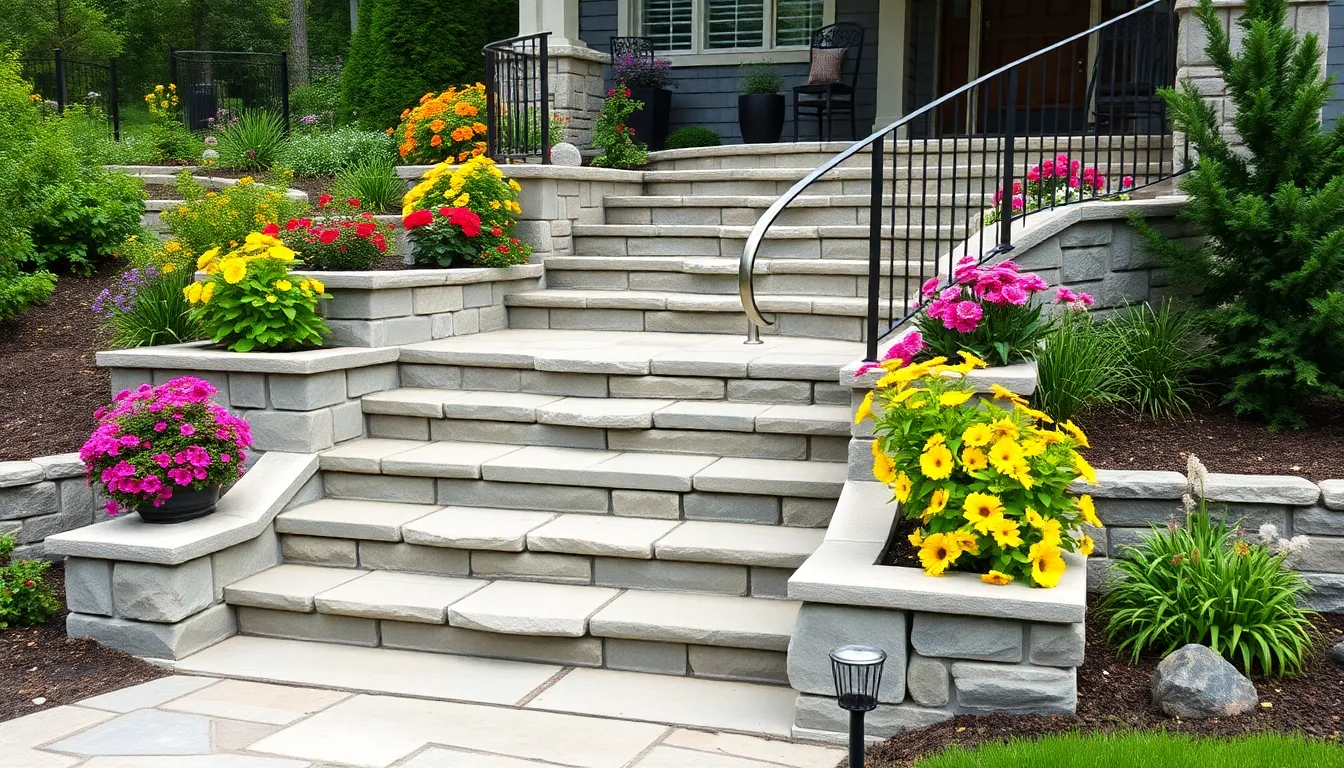
Multi-level entrances transform ordinary garden access points into dramatic architectural features that add both visual interest and practical functionality. Strategic use of steps and terracing helps manage slopes while creating natural stopping points that guide visitors through your outdoor space.
Build Natural Stone Steps
Natural stone steps provide the foundation for any multi-level entrance design. Flagstone offers excellent slip resistance and weathers beautifully over time, while limestone creates a clean, sophisticated appearance that complements both traditional and modern garden styles. Sandstone delivers warm earth tones that blend seamlessly with surrounding plantings.
Stone thickness matters significantly for durability and safety. We recommend using stones at least 2 inches thick for heavy foot traffic areas. Proper base preparation includes 4-6 inches of compacted gravel beneath each stone to prevent settling and cracking.
Installation requires careful attention to rise and run measurements. Each step should have a consistent 6-7 inch rise with a 12-14 inch tread depth for comfortable navigation. Well-lit steps ensure safe passage during evening hours, so consider incorporating low-voltage LED strip lights along the edges.
Add Retaining Walls With Integrated Planters
Retaining walls serve dual purposes by managing soil erosion while creating structured planting opportunities. Natural stone walls blend organically with garden surroundings and require minimal maintenance once properly constructed. Brick alternatives offer more uniform appearance and work particularly well with colonial or traditional home styles.
Integrated planters within retaining walls maximize planting space without requiring additional square footage. Built-in drainage systems prevent water damage and ensure healthy plant growth. We suggest incorporating weep holes every 4-6 feet along the wall’s base to manage moisture effectively.
Plant selection for integrated planters should focus on species that thrive in contained environments. Ornamental grasses like fountain grass or blue fescue provide year-round structure, while seasonal flowers such as petunias or marigolds add color throughout growing seasons. Trailing plants like ivy or creeping phlox soften hard edges and create natural transitions.
Incorporate Handrails for Safety and Style
Handrails enhance both safety and visual appeal on stepped entrances. Metal railings offer durability and can be powder-coated in colors that complement your home’s exterior palette. Wrought iron provides classic elegance, while contemporary steel designs suit modern architectural styles.
Wooden handrails create warmth and natural texture that pairs beautifully with stone steps. Cedar and redwood resist weather damage naturally, while pressure-treated pine offers budget-friendly longevity. Regular staining or sealing maintains wood’s appearance and extends its lifespan.
Height specifications require railings to measure 34-38 inches for optimal safety and comfort. Spacing between balusters shouldn’t exceed 4 inches to prevent accidents. Consider incorporating integrated lighting within handrail posts to illuminate steps while maintaining clean design lines.
Design Seasonal Container Gardens
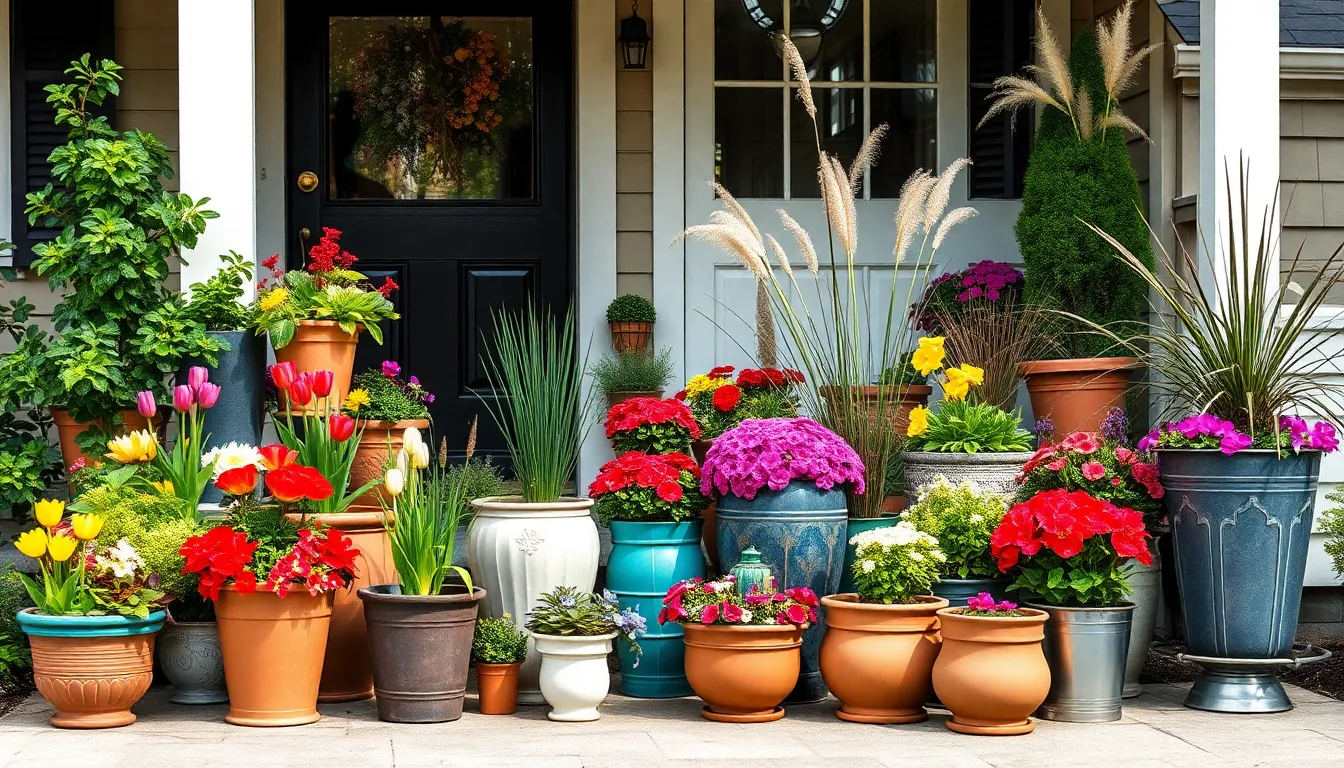
Container gardens at your entrance maintain visual interest throughout every season while providing flexibility to adapt your display as plants and styles evolve.
Choose Containers That Complement Your Style
We recommend selecting containers that match your home’s architectural style to create a cohesive entrance design. Ceramic containers work beautifully with traditional homes, while terracotta pots complement Mediterranean and rustic styles perfectly. Metal containers suit modern and industrial designs, and wooden planters blend seamlessly with craftsman and farmhouse aesthetics.
Materials matter significantly when choosing long-term container answers for entrance displays. Ceramic and terracotta containers offer classic appeal but require protection during freeze-thaw cycles in colder climates. Metal containers provide durability and contemporary styling, though they may heat up quickly in direct sunlight. Wood containers create natural warmth and blend with garden landscapes, yet they need regular maintenance to prevent decay.
Size considerations ensure your containers make the right impact at your entrance scale. Large containers work best for prominent entrance features, while medium-sized pots complement doorway areas without overwhelming the space. Small containers excel as accent pieces when grouped together or used to highlight exact architectural details.
Plan for Year-Round Color and Interest
We design our seasonal rotations to feature different plants throughout each season, ensuring continuous color and texture at the entrance. Spring bulbs like tulips and daffodils provide early season excitement, while summer annuals such as petunias and marigolds deliver vibrant color during peak growing months. Autumn brings opportunities for ornamental grasses and mums, and winter evergreens or berry-producing plants maintain structure and interest.
Plant selection strategies focus on choosing varieties that thrive in your exact climate conditions. Cool-season plants like pansies and ornamental cabbage perform well during spring and fall transitions. Heat-tolerant options including zinnias and portulaca handle summer stress effectively. Winter-hardy selections such as boxwood and holly provide structure when other plants enter dormancy.
Texture combinations create visual depth even when flowers aren’t in bloom. Combine fine-textured plants like asparagus fern with bold-leaved specimens such as caladium or coleus. Add spiky elements through ornamental grasses or upright evergreens, then soften edges with trailing varieties like ivy or sweet potato vine.
Group Containers for Maximum Visual Impact
We arrange containers of varying heights and shapes to create ever-changing entrance displays that draw visitors toward your door. Tall containers serve as anchor points in arrangements, while medium-height pots fill middle spaces and provide transition between elements. Short containers work perfectly as foreground pieces or to create base layers in grouped arrangements.
Odd numbers create more natural-looking groupings that feel less formal than even-numbered arrangements. Three containers of different sizes work well for small entrance areas, while five or seven containers can fill larger spaces effectively. Stagger placement depths rather than lining containers in rows to add visual dimension and encourage exploration.
Color coordination between containers and plantings ensures cohesive entrance displays throughout seasonal changes. Neutral container colors like terra cotta, stone gray, or natural wood allow plant colors to dominate the display. Bold container colors work best when repeated in small doses or when plants complement rather than compete with the container hues.
Install Outdoor Lighting for Safety and Drama
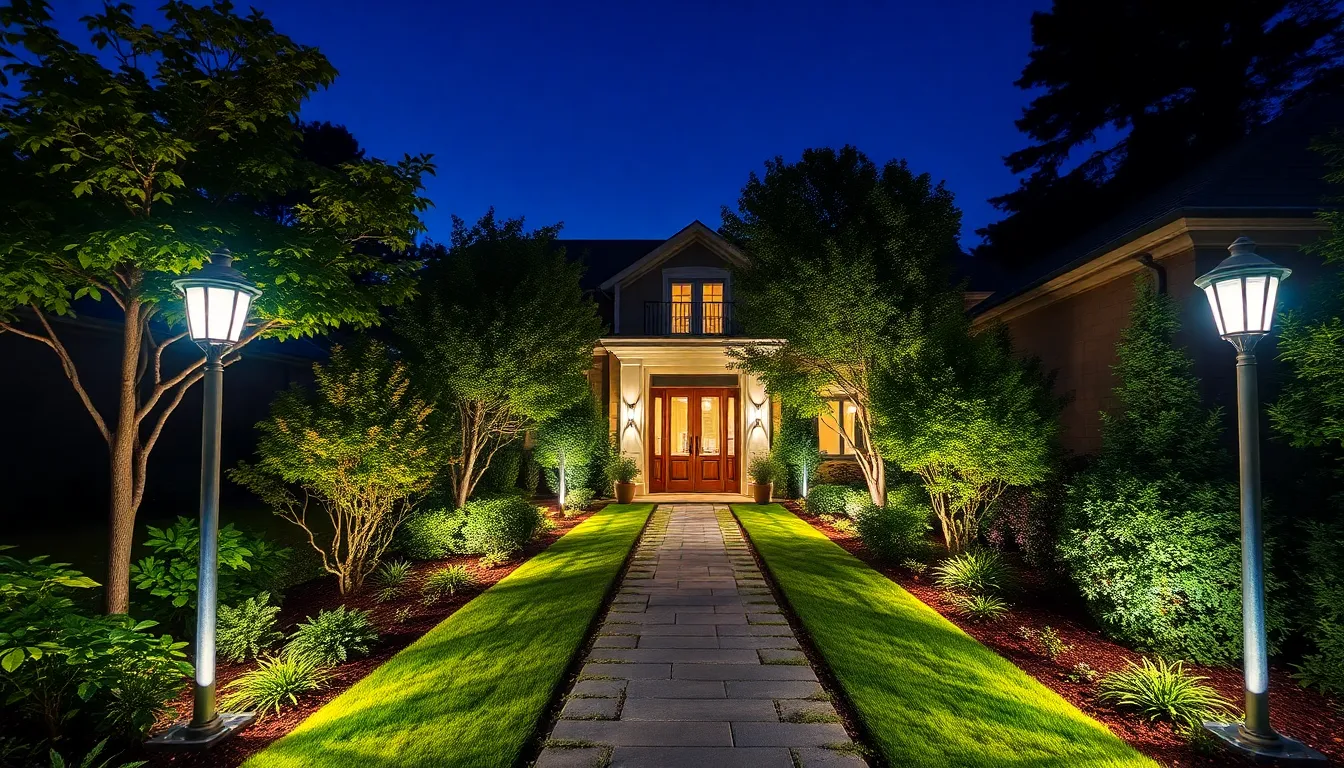
Strategic lighting transforms your garden entrance from a simple pathway into an enchanting nighttime experience. Proper illumination enhances security while showcasing your industry’s most beautiful features after dark.
Use Path Lights to Guide Visitors
Path lights create a welcoming corridor that safely guides visitors from the street to your front door. We recommend spacing fixtures 6 to 8 feet apart along both sides of walkways to ensure adequate coverage without creating harsh shadows.
Low profile bollard lights work exceptionally well for straight pathways, while lantern style fixtures complement curved walkways and traditional home designs. These fixtures should cast light downward at a 30 degree angle to minimize glare while maximizing ground illumination.
Solar powered path lights offer an eco friendly installation option that requires no electrical wiring. Modern solar units provide 8 to 12 hours of continuous illumination after a full day of charging, making them reliable for year round use.
Timer controls allow you to customize when path lighting activates, typically from dusk until midnight or dawn. Smart lighting systems can integrate with home automation platforms, letting you control brightness levels and scheduling remotely through smartphone apps.
Add Uplighting for Trees and Architectural Features
Uplighting creates dramatic shadows that transform ordinary trees into stunning nighttime sculptures. We position fixtures 3 to 6 feet from tree trunks, angling them upward at 45 degrees to highlight bark texture and branch structure without damaging foliage.
Architectural features benefit from strategic uplighting placement that emphasizes columns, arches, and decorative stonework. Narrow beam fixtures work best for highlighting exact details, while wide beam lights illuminate larger surfaces like retaining walls or entrance pillars.
Grazing techniques involve placing lights close to textured surfaces like stone walls or wooden fences to create interesting shadow patterns. This method requires fixtures positioned 6 to 12 inches from the surface, casting light parallel to the wall rather than directly at it.
Color temperature selection affects the mood your uplighting creates, with warm white (2700K to 3000K) providing cozy ambiance and cool white (4000K to 5000K) offering crisp, modern appeal. Colored filters can add seasonal interest for special occasions or holidays.
Choose Energy Efficient LED Options
LED fixtures consume 75% less energy than traditional incandescent bulbs while lasting 25 times longer, making them the most cost effective choice for outdoor lighting installations. These fixtures typically provide 15,000 to 50,000 hours of operation before requiring replacement.
Lumens per watt ratings help determine LED efficiency, with quality outdoor fixtures producing 80 to 120 lumens per watt compared to 10 to 15 lumens per watt for incandescent alternatives. Higher ratings translate to brighter light output with lower electricity consumption.
Weather resistant construction ensures LED fixtures withstand outdoor conditions, with IP65 ratings providing protection against dust and water jets from any direction. Aluminum housings resist corrosion better than plastic alternatives, especially in coastal environments with salt air exposure.
Dimming capabilities allow you to adjust brightness levels throughout the evening, starting at full intensity for safety during peak activity hours and reducing to 30% for ambient lighting later at night. Compatible dimmer switches and controllers expand your lighting design flexibility while reducing energy consumption.
Conclusion
We’ve explored countless ways to transform your garden entrance from ordinary to extraordinary. Whether you’re drawn to rustic wooden gates or sleek modern archways the key is choosing elements that reflect your personal style while creating a cohesive design.
Remember that the most impactful entrances combine multiple elements thoughtfully. A beautiful gate paired with strategic lighting and seasonal plantings creates layers of visual interest that welcome visitors year-round.
Your garden entrance doesn’t require a massive budget or professional installation to make a statement. Start with one focal element and build from there allowing your entrance to evolve naturally over time. The journey of creating your perfect garden entrance can be just as rewarding as the final result.
Frequently Asked Questions
What makes a garden entrance important for overall outdoor design?
A well-designed garden entrance sets the tone for your entire outdoor space and creates a lasting first impression. It serves as the focal point that welcomes visitors and transitions them from the outside world into your garden sanctuary. Even small changes like adding lighting or climbing vines can significantly enhance the entrance’s impact and overall aesthetic appeal.
Which materials work best for arbors and pergolas in different climates?
Choose materials based on your local weather conditions. Cedar and redwood are ideal for wet climates due to their natural moisture resistance. Aluminum and steel handle extreme weather best, while pressure-treated pine offers budget-friendly durability. For low maintenance options, consider vinyl or composite materials that resist weathering and require minimal upkeep.
What are the best climbing plants for garden entrance structures?
Popular climbing plants include clematis for colorful blooms, climbing roses for classic beauty, grape vines for edible appeal, and wisteria for dramatic flowering displays. Choose plants based on your climate zone, desired maintenance level, and the amount of sunlight your entrance receives. These plants add natural beauty while softening architectural elements.
How do curved pathways enhance garden entrance design?
Curved walkways create visual interest and build anticipation as visitors approach your garden. Unlike straight paths, curves add mystery and encourage slower, more contemplative movement through the space. They work well with materials like brick and small pavers that can easily accommodate gentle bends and flowing designs.
What lighting options work best for garden entrance pathways?
Low voltage LED systems and solar-powered lights are recommended for pathway illumination. LED lights are energy-efficient and long-lasting, while solar options eliminate wiring needs. Place fixtures strategically to guide visitors safely while creating ambiance. Choose warm color temperatures (2700K-3000K) for a welcoming atmosphere during evening hours.
How do I choose the right gate material for my garden entrance?
Select gate materials that complement your home’s architectural style and local climate. Wood gates offer warmth and natural beauty, metal provides durability and security, while vinyl requires minimal maintenance. Consider factors like weather resistance, maintenance requirements, privacy needs, and decorative preferences when making your selection.
What are the benefits of automated garden gates?
Automated gates provide convenience, enhanced security, and accessibility benefits. Electric and solar-powered systems eliminate the need to manually open heavy gates. They often include safety features like obstacle detection and can be integrated with access control systems such as keypads, remote controls, or smartphone apps for added security.
How can raised planter boxes enhance my garden entrance?
Raised planter boxes create defined spaces and add vertical interest to flat entrances. They’re easier to maintain than ground-level beds, provide better drainage, and can be filled with seasonal flowers for year-round color. Choose durable materials and consider integrated irrigation systems for efficient watering and plant health.
What water features work well at garden entrances?
Small fountains and bubblers add soothing sounds and visual appeal without overwhelming the space. Reflecting pools can mirror surrounding architecture and plantings for enhanced design impact. Solar-powered pumps offer eco-friendly operation, while proper placement ensures water features complement rather than compete with other entrance elements.
How can I incorporate art and signage into my garden entrance?
Custom welcome signs, sculptural pieces, and vintage decorative items personalize your entrance and reflect your style. Choose materials that withstand weather conditions and complement your overall design theme. Position art pieces strategically to create focal points without cluttering the space, and consider scale to ensure proportional balance.
What should I consider when designing multi-level garden entrances?
Multi-level entrances require careful planning for safety and aesthetics. Use natural stone steps for durability and visual appeal, ensure proper installation techniques, and include handrails where needed. Incorporate retaining walls with integrated planters to manage soil and maximize planting opportunities while creating dramatic architectural interest.
How do I maintain year-round interest with container gardens at my entrance?
Plan seasonal rotations using plants that thrive in your climate during specific times of year. Group containers of varying heights for visual impact and choose vessels that complement your home’s style. Select durable container materials and ensure proper drainage. Coordinate colors between containers and plantings for cohesive, attractive displays.

